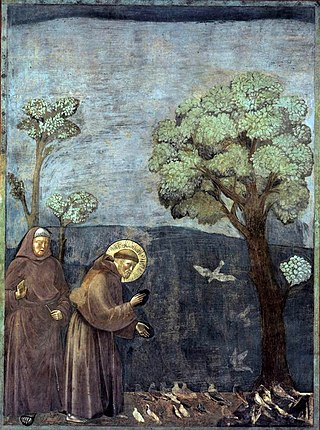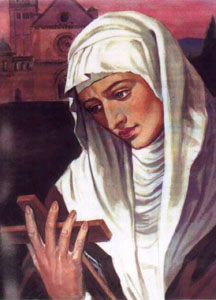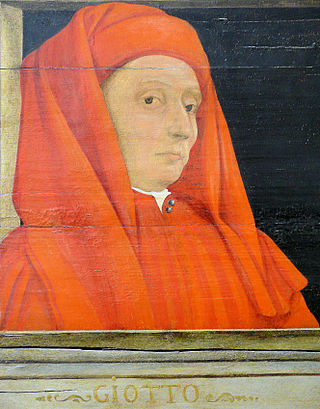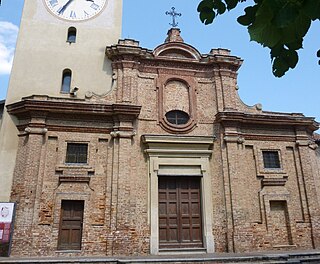Related Research Articles

Giovanni di Pietro di Bernardone, known as Francis of Assisi, was an Italian mystic, poet and Catholic friar who founded the religious order of the Franciscans. He was inspired to lead a Christian life of poverty as a beggar and itinerant preacher. One of the most venerated figures in Christianity, Francis was canonized by Pope Gregory IX on 16 July 1228. He is commonly portrayed wearing a brown habit with a rope tied around his waist, featuring three knots that symbolize the three Franciscan vows of poverty, chastity, and obedience.

Stigmata, in Catholicism, are bodily wounds, scars and pain which appear in locations corresponding to the crucifixion wounds of Jesus Christ: the hands, wrists, feet, near the heart, the head, and back.
The Fraticelli or Spiritual Franciscans opposed changes to the rule of Saint Francis of Assisi, especially with regard to poverty, and regarded the wealth of the Church as scandalous, and that of individual churchmen as invalidating their status. The Fraticelli were declared heretical in 1296 by Boniface VIII.

Simone Martini was an Italian painter born in Siena. He was a major figure in the development of early Italian painting and greatly influenced the development of the International Gothic style.

Pietro Lorenzetti or Pietro Laurati was an Italian painter, active between c. 1306 and 1345. Together with his younger brother Ambrogio, he introduced naturalism into Sienese art. In their artistry and experiments with three-dimensional and spatial arrangements, the brothers foreshadowed the art of the Renaissance.
The anonymous text that is usually called the Prayer of Saint Francis is a widely known Christian prayer for peace. Often associated with the Italian Saint Francis of Assisi, but entirely absent from his writings, the prayer in its present form has not been traced back further than 1912. Its first known occurrence was in French, in a small spiritual magazine called La Clochette, published by a Catholic organization in Paris named La Ligue de la Sainte-Messe. The author's name was not given, although it may have been the founder of La Ligue, Father Esther Bouquerel. The prayer was heavily publicized during both World War I and World War II. It has been frequently set to music by notable songwriters and quoted by prominent leaders, and its broadly inclusive language has found appeal with many faiths encouraging service to others.
In Catholic tradition, the Five Holy Wounds, also known as the Five Sacred Wounds or the Five Precious Wounds, are the five piercing wounds that Jesus Christ suffered during his crucifixion. The wounds have been the focus of particular devotions, especially in the late Middle Ages, and have often been reflected in church music and art.

The Basilica of Saint Francis of Assisi is the mother church of the Roman Catholic Order of Friars Minor Conventual in Assisi, a town in the Umbria region in central Italy, where Saint Francis was born and died. It is a papal minor basilica and one of the most important places of Christian pilgrimage in Italy. With its accompanying friary, Sacro Convento, the basilica is a distinctive landmark to those approaching Assisi. It has been a UNESCO World Heritage Site since 2000.

Saint François d'Assise : Scènes Franciscaines, or simply Saint François d'Assise, is an opera in three acts and eight scenes by French composer Olivier Messiaen, who was also its librettist; written from 1975 to 1979, with orchestration and copying from 1979 to 1983. It concerns Saint Francis of Assisi, the titular character, and displays Messiaen's devout Catholicism.

Agnes of Assisi was a younger sister of Clare of Assisi and one of the first abbesses of the Order of Poor Ladies. Pope Benedict XIV canonized her as a saint in 1753.

The tau cross is a T-shaped cross, sometimes with all three ends of the cross expanded. It is called a “tau cross” because it is shaped like the Greek letter tau, which in its upper-case form has the same appearance as Latin letter T.

In Christian theology, the imitation of Christ is the practice of following the example of Jesus. In Eastern Christianity, the term life in Christ is sometimes used for the same concept.

Assisi Cathedral, dedicated to San Rufino, is a major church in Assisi, Italy. This stately church in Umbrian Romanesque style was the third church built on the same site to contain the remains of bishop Rufinus of Assisi, martyred in the 3rd century. The construction was started in 1140 to the designs by Giovanni da Gubbio, as attested by the wall inscription visible inside the apse. He may be the same Giovanni who designed the rose-window on the façade of Santa Maria Maggiore in 1163.

Bernard of Quintavalle was the first disciple of St. Francis of Assisi. Bernard was declared as the Minorum Ordinis prima plantula, the "First fruits of the Minor Orders". He accompanied Francis on a number of missionary journeys and served as Minister Provincial in Spain.
Francis Gladden Bishop was a minor leader in the Latter Day Saint movement after the 1844 succession crisis. Bishop claimed to be the rightful successor to Joseph Smith; from the 1850s until his death, Bishop led a succession of small groups of Latter Day Saints and converts. His followings have been identified informally by later writers as the Gladdenites and the Church of Jesus Christ of Latter Day Saints (Gladdenite), though the name of a late following is formally The Church of Jesus Christ of the New Jerusalem. In the 1850s, many of Bishop's followers abandoned him and joined the movement that would later become the Church of Christ.

Thanksgiving after Communion is a spiritual practice among Christians who believe in the Real Presence of Jesus Christ in the Communion bread, maintaining themselves in prayer for some time to thank God and especially listening in their hearts for guidance from their Divine guest. This practice was and is highly recommended by saints, theologians, and Doctors of the Church.

Francesco is a 1989 historical drama film about the life of St. Francis of Assisi. It is directed and co-written by Liliana Cavani, and stars Mickey Rourke as Francis and Helena Bonham Carter as the future St. Claire. The screenplay is adapted from Hermann Hesse’s 1904 book Francis of Assisi. Vangelis composed the musical score.

Chiara Offreduccio, known as Clare of Assisi, was an Italian saint who was one of the first followers of Francis of Assisi.

Giotto di Bondone, known mononymously as Giotto and Latinised as Giottus, was an Italian painter and architect from Florence during the Late Middle Ages. He worked during the Gothic and Proto-Renaissance period. Giotto's contemporary, the banker and chronicler Giovanni Villani, wrote that Giotto was "the most sovereign master of painting in his time, who drew all his figures and their postures according to nature" and of his publicly recognized "talent and excellence". Giorgio Vasari described Giotto as making a decisive break from the prevalent Byzantine style and as initiating "the great art of painting as we know it today, introducing the technique of drawing accurately from life, which had been neglected for more than two hundred years".

San Giorgio Martire is a Baroque-style, Roman Catholic church located in the town of Chieri, in the metropolitan city of Turin, in the region of Piedmont, Italy.
References
- ↑ Sons of Francis, by Anne Macdonell, JM Dent & Co., GP Putnam's Sons, printed by Ballantyne, Hanson, and Co. (1902); page 80.